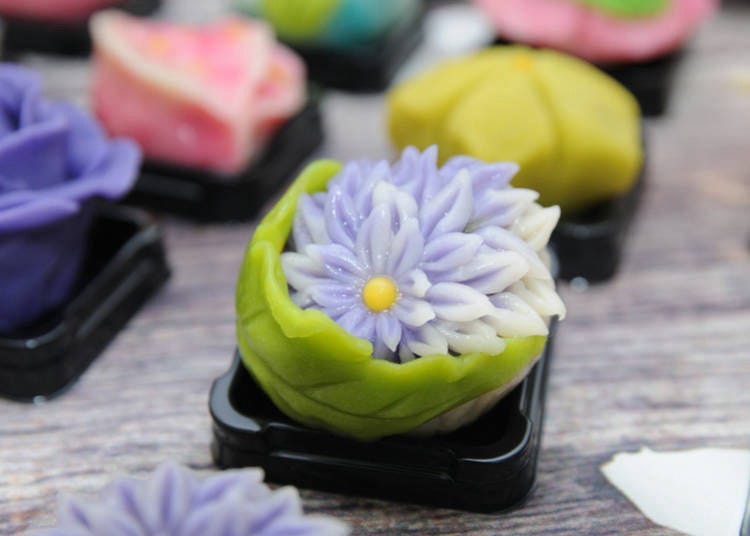
10 Awesome Japanese Sweets You Didn't Know Existed
- Written by: Lucio Maurizi
Among many other things, Japan is famous for its food. In fact, some Japanese dishes are probably one of the better-known features of this country. Sometimes, the many amazing (and oftentimes unique) Japanese sweets that populate Japanese culinary culture sometimes go unnoticed.
Like other Japanese dishes, there are a great number of Japanese sweets! Many of these traditional sweets belong exclusively to Japanese tradition and are generally encompassed by the term wagashi. Wagashi refers to typical Japanese confections usually served with a beverage or other dishes. Oftentimes they are created specifically to accompany a specific tea or drink.
While Japanese cuisine is reach of sweets such as cakes, baked goods, and pastries, you’ll find that many of the “very Japanese” sweets are wagashi.
While some of these have found their place on dessert menus abroad, most tend to be available just in Japan. We’ve selected just 10 of the must-try ones for when you visit the country!
1. Senbei and Arare
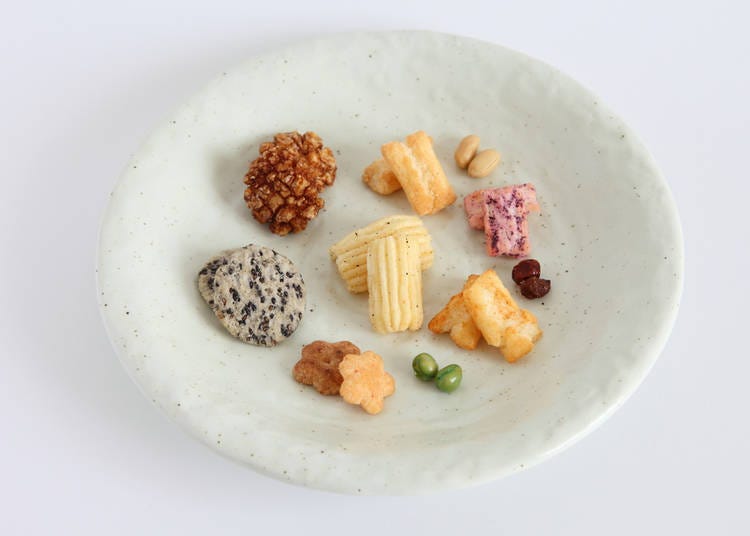
It's fitting to start talking about Japanese sweets with senbei and arare. These snacks are not only widely popular in Japan, but they have been accompanying people's meals for over 1000 years.
Senbei and arare are crackers you'll find in various shapes and flavors. Senbei is commonly known in the West as 'rice crackers .' They can be found salty, flavored with soy sauce, and even wrapped in nori (Japanese seaweed). But there are dozens of sweet ones, usually served with green tea. The Kansai senbei is made with glutinous rice and tends to be more delicate and lightly seasoned than its Kanto counterpart, which is crunchier and more richly flavored.
Arare is similar to senbei. What really distinguishes the two is the shape. Arare is prepared to resemble snow pellets. They are smaller than senbei, but both snacks share a variety of ways to be prepared. Arare, too, can be salty or sweet. They are one of the preferred snacks accompanying beer, but also (in different varieties) tea and other drinks.
Arare are traditionally consumed during the Hinamatsuri festival (Girls Day in Japan) on May 3. These arare are usually very colorful, ranging from pink to green, white, yellow, brown, and more.
2. Coffee Jelly
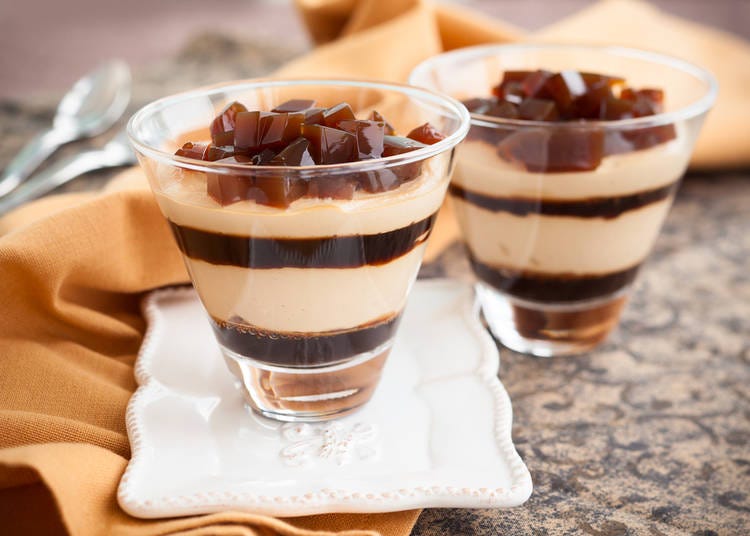
Coffee Jelly is perhaps one of the more popular desserts in Japan. It's prepared by mixing sweetened coffee with agar agar, a gelatin made from red algae. The jelly is then served on its own or mixed with various drinks, such as milk, coffee, shakes, or ice cream floats, sundaes, and more.
Coffee Jelly is now mostly prepared in Japan, but its origins seem to be in the early 19th century in England. During that time, it became popular in the United States, although the preparation in the west used and used gelatin instead of agar agar. Unlike many others belonging to a long-lasting Japanese tradition, this staple dessert has made its appearance in the country only in the second decade of the 20th century. Today you can find it at many cafes and restaurants, and even at convenience stores in Japan!
3. Daifuku
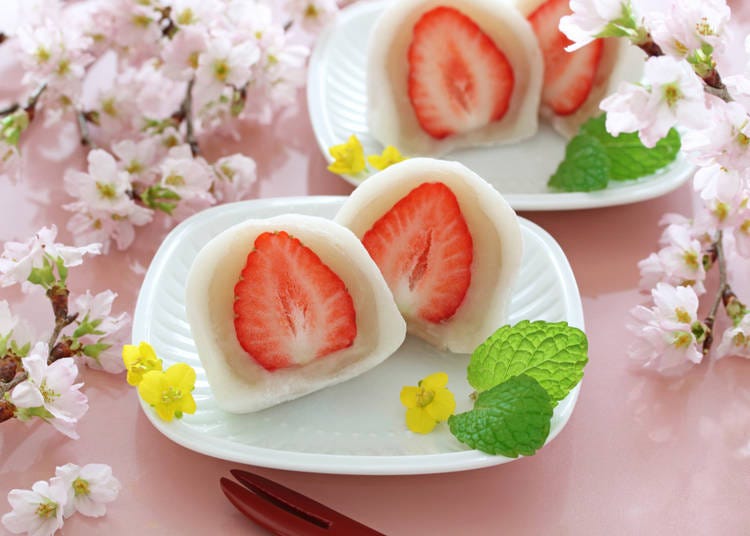
Daifuku or Daifukumochi is a small round mochi filled with a variety of ingredients, most commonly pureed adzuki red beans. Mochi is a glutinous rice cake used for various dishes, daifuku being one of the most popular. This confection usually comes in two sizes, small, and large (about the size of a hand's palm). The cakes are covered with starch and, at times, sugar.
At its inception, daifuku was called Habutai Mochi (belly thick rice cake), describing its nature and preparation. Later its name changed to Daifuku (big belly). The name stuck through the centuries because the pronunciation of "belly" and that of "luck" is the same in Japanese, making the name of the cake "Great Luck Rice Cake."
Daifuku can also be made into ice cream. One variation, called Yukimi Daifuku (Snow-viewing Daifuku), is a mochi cake filled with vanilla, chocolate, or green tea ice cream and then dipped in coconut milk.
Another trendy variation of daifuku is Ichigo Daifuku (strawberry daifuku). This dessert is served only during strawberry season, and it's prepared by wrapping a strawberry with a layer of mochi and red beans paste, making for a tasty and original treat.
4. Dorayaki
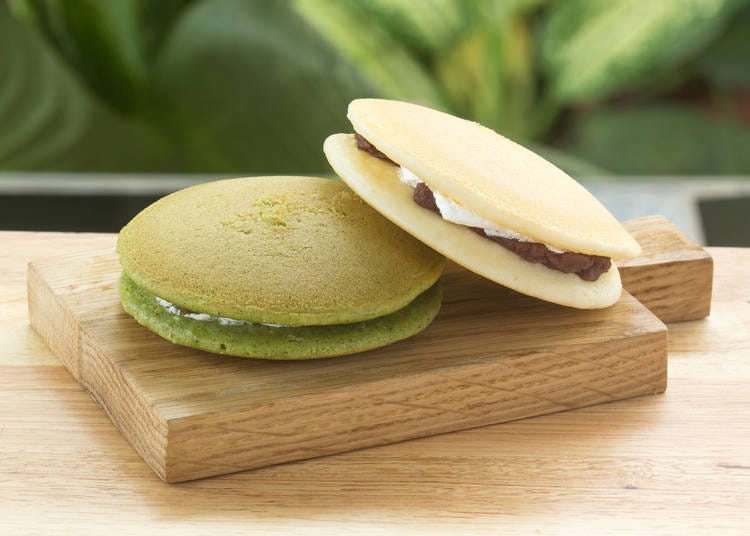
Some of you may know dorayaki from the famous manga and anime series Doraemon. In the series, the character who gives the name to the manga is addicted to dorayaki. He consumes them in massive amounts, and they are often used as a plot device in various episodes.
Dorayaki is a pancake-like sandwich made from castella, a Nagasaki specialty soft cake introduced in Japan by Portuguese merchants in the 16th century. The cake is then filled with red beans paste.
The word dora in Japanese means "gong," and given the shape of this treat, this is probably the origin of its name.
Dorayaki are very popular across Japan, but sometimes, depending on the area, they may have another name. If you're ever craving Dorayaki while in Kansai (for example, in Osaka, Kyoto, or Nara), ask for a mikasa.
5. Manju

Manju is a confection that presents a myriad of varieties, but the most common one is an outside layer made with flour, rice powder, buckwheat, and kudzu (a plant). The filling is made of red beans paste (possibly the most common ingredient for Japanese sweets). Other fillings include chestnut jam (Kuri Manju) or orange-flavored cream.
Similar to other sweets and dishes, in general, belonging to Japanese culture, manju, too, has been modified in many areas of Japan. The Okinawan manju (also very popular in Hawaii) is prepared with a filling of purple sweet potatoes, butter, milk, sugar, and salt, or with various kinds of bean paste.
Saitama, a prefecture north of Tokyo, has its own Jumangoku Manju. The outer layer is prepared with more rice, giving it a different texture, and the red beans paste is prepared without using the peel of the beans, making it smoother. The preparation of this dessert has been part of Saitama tradition since 1945, and the preparation is said to have remained the same.
You can also enjoy a green tea manju with a green, tea-flavored outer layer.
Finally, if you're looking for a perfect souvenir, look for the Momiji Manju. These are manju prepared in the shape of the famous Japanese maple trees' leaves (momiji) and have been literally created to be souvenirs. In the late Meiji period, Takatsu Tsunesuke, a wagashi (Japanese sweets) maker, was commissioned by a ryokan (Japanese-style hotel) owner to craft sweets that would be good souvenirs for visitors. The ryokan was located in the so-called Momiji Valley in Miyajima, which inspired Tsunesuke to perfect the Momiji Manju.
6. Mochi
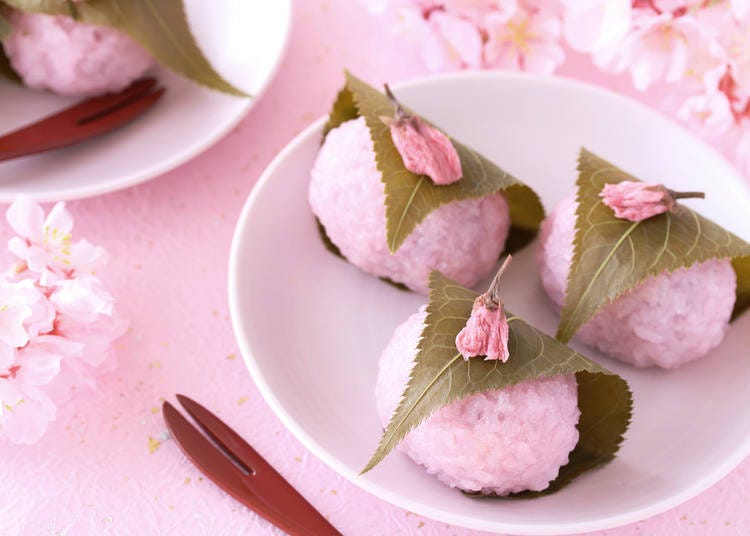
Mochi is one of the main staples of Japanese food, especially when it comes to sweets.
Mochi is a rice cake made of glutinous rice, and prepared by pounding it into a paste, and modeling it into the desired shape.
Mochi is prepared all year-round, but it's such an important component of Japanese culture that there's a ceremony called mochitsuki (mochi preparation), which takes place around the last day of the year (different families do it on different days, trying to do it on a "lucky" day according to the calendar).
Mochi can be steamed, grilled, boiled, and added to various other ingredients. More importantly, it makes for amazing desserts.
Sakura mochi is one of the prettiest desserts out there. Usually favored during spring as a snack to eat during cherry flowers viewing, it's also the traditional dessert for Girl's Day (March 3).
Sakura mochi is a pink-colored rice cake filled with red beans paste, and wrapped in a sakura tree leaf.
An all-time favorite summer dessert in Japan is Kuzumochi. This extremely light dessert is made with mochi, kudzu powder, sugar, and water. Kuzumochi is served chilled, topped with kuromitsu (lit. black honey, a Japanese syrup) and kinako (roasted soybeans flour).
Mochi is also used in one of the most important dishes in Japanese tradition. Hanabiramochi is a confection usually eaten at the beginning of the year, following the tradition set by the imperial families of the past who would celebrate the beginning of the year, and many other important events, by eating this dessert.
The preparation and shape of hanabiramochi are strictly defined by tradition. The shape is that of a petal. The mochi layers must be light pink, and mustn't seal the filling, made of red beans paste, sweetened mung beans, and a flavored burdock strip.
This desert is also rich in symbolism, with its colors being evocative not only of the ume (plum) and sakura blossoms (which themselves represent purity, perseverance, and renewal) but also of the new year. The burdock (gobo) represents pressed ayu, a fish exclusive to east Asia, symbolic of long life.
7. Namagashi
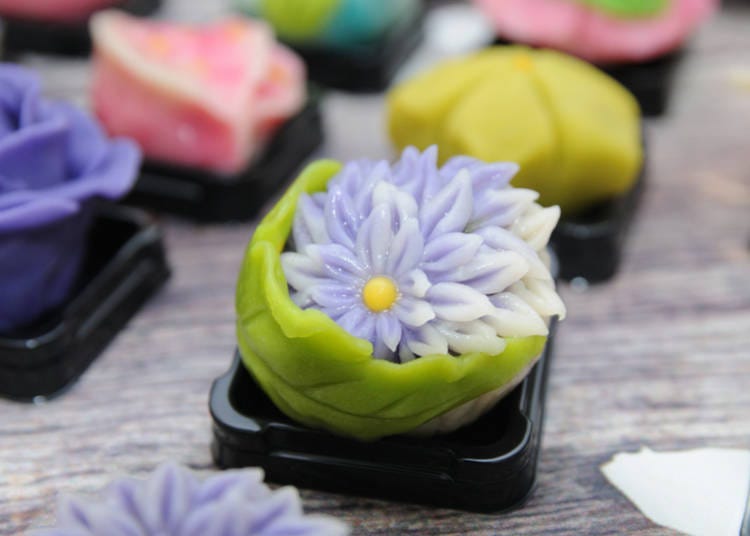
Namagashi are additive free, always freshly made wagashi that usually accompany tea ceremonies.
Namagashi are shaped to reflect the season in which they are served. Namagashi makers are often regarded as masters (similarly to sushi chefs) and learning how to properly prepare this treat can take decades, with techniques that require precision, stamina, creativity, and balancing of textures and flavors.
While they can be prepared in numerous different ways, namagashi often contain fruit jelly, or other gelatins, or sweetened beans paste.
8. Taiyaki

Taiyaki is a curious fish-shaped cake, named after the fish it represents tai – or sea bream.
The outer layer is made with pancake or waffle batter. The filling is where this sweet becomes even more original. The most common one is red beans, but it can also be found with fillings of custard, chocolate, and sweet potatoes.
Conspicuously absent is any fish ingredient, so no need to worry about biting into these desserts and discovering a fishy surprise! Despite being technically desserts, you can also find them with a cheese filling, and, in some rare cases, even with gyoza, okonomiyaki, or sausage fillings.
Taiyaki made its appearance in Japan during the Meiji period, but disappeared during WWII, due to the shortage of food.
After Japan recovered from the war, they made a sweeping comeback and are now extremely common as street food, and one of the most popular foods served during festivals all over the country.
9. Yatsuhashi

This confection is a Japanese sweet that became very popular, especially as a souvenir, gaining the nickname of Miyagegashi (lit. souvenir sweet).
Yatsuhashi is one of the main typical products of Kyoto, and it's made with mochi, sugar, and cinnamon.
There are actually two varieties of yatsuhashi: one has a hard texture (as it’s baked) and an intense aroma from the cinnamon spice. The other type of yatsuhashi, called Nama Yatsuhashi, is made from steamed mochi cut into a thin triangular shape and served as is, or with a filling of red beans (or other sweet) paste.
If you happen to be in Kyoto during your trip to Japan, you will most likely stumble upon this treat. Don't miss out.
10. Yokan
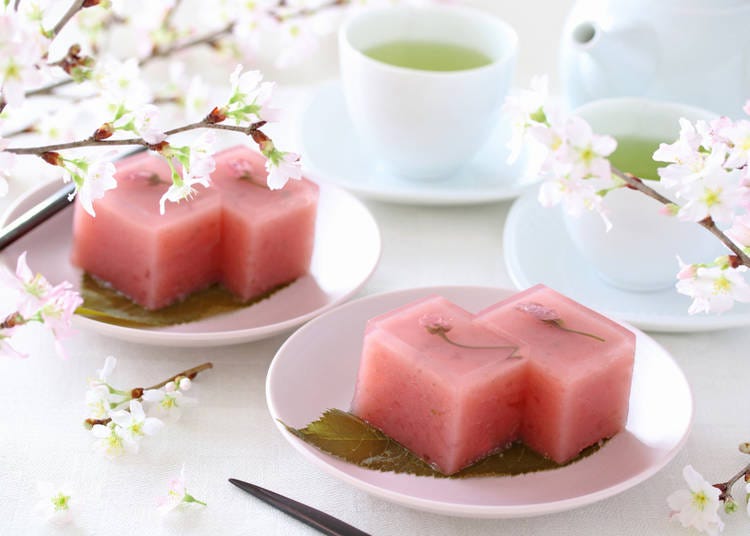
Yokan is another gelatinous dessert made with agar agar, sugar, and red beans. In Japan, you'll find it in small blocks, or slices.
Yokan makes for a perfect accompanying dessert for tea, coffee, cookies, or other sweets.
Mizu yokan (water yokan) is made using more water than its more standard counterpart, making for a lighter and more refreshing dessert, usually served in summer.
Yokan seems to have a long history, introduced to Japan almost 1000 years ago by Zen monks. This sweet originated in China, where the gelatin component of Yokan was derived from boiled sheep fat. Since Buddhism forbids the killing or eating of animals, the monks replaced animal gelatin.
Yokan can also be found with green tea flavoring (in this case, white beans instead of red beans are used, since they have a less dominant flavor). Yokan can also contain chopped chestnuts, figs, sweet potatoes, and other flavors, making it a never-boring dessert.
Those of you visiting the country in summer will be happy to know that June 16 is Wagashi Day in Japan. That's right, a nationwide 1200 years old celebration of amazing Japanese sweets, during which wagashi makers from all over Japan will be serving their best products!
Lucio Maurizi is an automotive expert specializing in Japan's car scene and auto-tourism. With an MA in East Asian History from La Sapienza Università di Roma, he's a multi-talented contributor to travel platforms like LIVE JAPAN, Japan Travel, and GPlus Media. His Instagram account (50k+ followers) offers insider views on Japan's automotive culture. Lucio also actively collaborates with professional drivers and influencers and organizes can't-miss car events in Tokyo.
- Area
- Category
*Prices and options mentioned are subject to change.
*Unless stated otherwise, all prices include tax.
Popular Tours & Activitiess
Recommended places for you
-
Ad

Complete Guide to Ueno's National Museum of Nature and Science, the Perfect Place to Visit on Rainy Days or With Children
-

First Japan Cherry Blossom 2026 Forecast Announced! Here's When & Where to See Sakura in Japan
-

Strawberries, Style, and Tokyo’s Coolest Neighborhood: Winter Afternoon Tea in Kichijoji
by: Guest Contributor
-

New in Ginza! Air BicCamera Ginza Opens with a Faster, More Convenient Shopping Experience
by: Guest Contributor
-
Ad

(Opening in Jan 2026) 'THE SUMO LIVE RESTAURANT HIRAKUZA GINZA TOKYO!' 5 Exciting Ways to Experience the World of Sumo!
-
Ad

Discover the "Miraculous Forest" in the Heart of Tokyo: The Institute for Nature Study (9 Minutes from JR Meguro Station)
Inspiration for Accommodations
-

Enjoy Mt. Fuji from the Comfort of Your Room! Recommended Ryokan with Mt. Fuji View
-

Stay Near the Cherry Blossoms! Hotels for Cherry Blossom Viewing in Tokyo
-

Family-Friendly Hotels with Free Shuttle to Disneyland: Convenient Access for a Magical Stay
-

Top Ranked Hakone Hotels with Mt. Fuji View: Enjoy Stunning Scenery from Your Private Space
-

Convenient Tokyo Hotels with Airport Shuttle: Ideal for Families and Heavy Luggage
-

Stunning Tokyo Tower View Hotels: Enjoy Spectacular Scenery from Your Private Space
-

Convenient Asakusa Hotels with Kitchens: Ideal for Extended Family Visits
-

Experience Luxury: Hakone's 10 Best Five-Star Accommodations
-

Enjoy Mt. Fuji Autumn Leaves! Top Hotels Near the Popular Autumn Leaves Corridor
-

Experience Hakone Fall Foliage from Your Room with Stunning Views
-

Autumn in Japan 2025: Fall Foliage Forecast & Where to Enjoy the Colorful Leaves (+Tour Info)
-

Shopping in Shibuya: 3 Hot Souvenir Shops and Popular Products Among Tourists!
-

Where to Buy Manga in Tokyo? 5 Collectors Share Tips & Favorite Spots
by: David McElhinney
-

6 Fun Things to Do at Tokyo's World-Famous Tsukiji Outer Market!
-

Quirky, Cute & More: Top 10 Items at Sanrio World Ginza!
-

Top 10 Best Japanese Cosmetics at Shibuya Loft: Makeup Must-Buys!
- #best ramen tokyo
- #what to buy in ameyoko
- #what to bring to japan
- #new years in tokyo
- #best izakaya shinjuku
- #things to do tokyo
- #japanese nail trends
- #what to do in odaiba
- #onsen tattoo friendly tokyo
- #daiso
- #best sushi ginza
- #japanese convenience store snacks
- #best yakiniku shibuya
- #japanese fashion culture
- #best japanese soft drinks



















